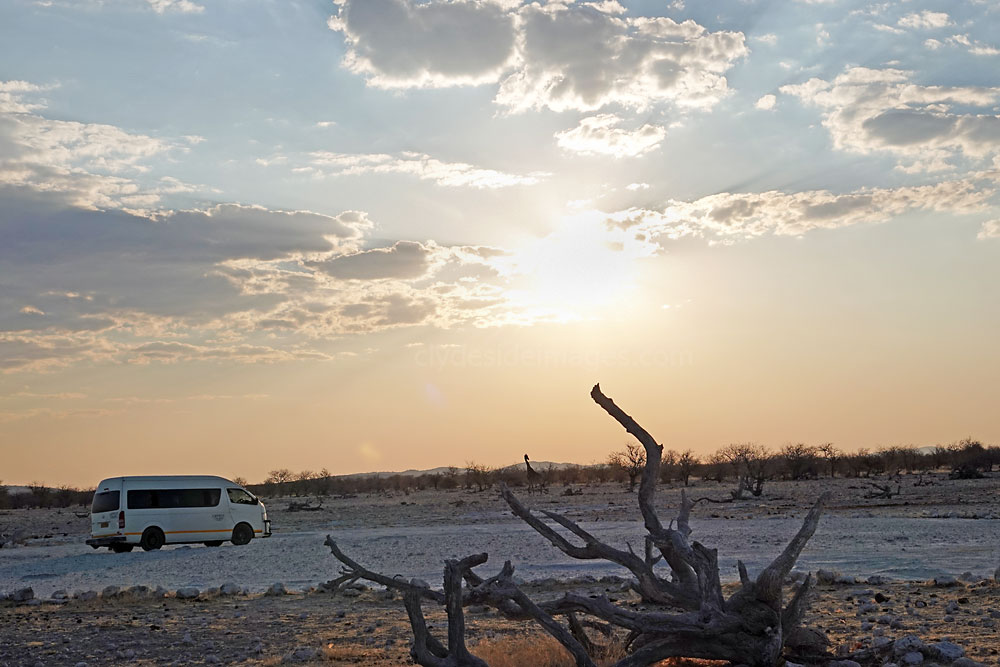Namibia
Etosha Waterholes
Ombika
Even though the Ombika waterhole lies very close to the Andersson Gate, and is the first such site passed en route to the Okaukuejo Rest Camp, it`s usually worth a look as the location is popular with many species, and supposedly a good place to spot lions although I`ve never seen any here. The name Ombika is a combination of an Owambo prefix, ‘om‘ and the Hai||om word ‘bika‘, which literally means to `force up and give water`. This source was originally used by people walking the old contract labour trail from the farming areas south of Etosha to Owambo in the north. Ombika is also apparently the name of a type of hand-pick which these early travellers utilised to dig down and reach the water.
|
The source is now a contact spring, supplemented during dry periods by a solar powered pump, so water is usually available all year-round. During periods of extreme drought, however, there are times when Ombika fails.
During the winter dry-season, the water level drops considerably and, as the pool is within a deep depression and quite far from the parking area, the animals, particularly the smaller ones, all but disappear from view when they start drinking. |
When the rains do come, the pool fills rapidly and overflows almost to the edge of the parking lot. Spring also brings the Catophractes alexandri and Acacia nebrownii into flower, which attracts large numbers of giraffe which feast on these blooms. These spectacular animals seem to favour Ombika whatever the season, however, and they were present most days when I visited during September and into October.
Please bear in mind that all my images are subject to copyright. They are not free to use and have been embedded with a digital watermark.
Giraffe, Black-faced Impala and Helmeted Guineafowl.
One day, while exploring Etosha on our second holiday, my wife and I had stayed at the Ozonjuitji m`Bari waterhole until midday before driving back to Okaukuejo. After filling up with diesel at the rest camp pumps, we headed for the Park exit, intending to spend the rest of the day relaxing at Etosha Safari Lodge. As we passed the turn-off for Ombika, we could see a herd of elephants at the waterhole so we drove in for a look. A couple of the National Park`s safari trucks with clients on board did likewise. It was a very peaceful scene with the animals looking very relaxed as they slaked their thirst.
After drinking and splashing around for a bit, the elephants all began to climb out. One of the matriarchs (on the right above) followed the calves, but without warning toppled over and went down like the proverbial `ton of bricks`, trumpeting in terror. To the human spectators and other elephants it initially looked as though she`d been shot, but her left foot had slipped on the muddy rim causing her to fall over. Her leg must have been badly twisted.
The poor beast was obviously shocked and in great pain but the other elephants gathered round and her partner patiently encouraged her to stand and eventually step cautiously out of the hole while he shooed-away unwanted spectators! The injured female managed to put weight on her foot and slowly walked off so it appeared that her leg wasn`t broken. The incident was just another reminder as to how precarious life can be for the animals trying to survive day-to-day here, irrespective of how large and powerful they are.
Further information on Namibia and additional images taken there can be found on Clydeside Images.com. Utilise the blog`s search box or the `Overseas-Namibia` fly-out label on the right-hand side of the blog page. Please bear in mind that my Stock Photography Archive has even more shots taken in Namibia. If you wish to purchase any image(s) please email using the Contact Form and I will respond at the earliest opportunity.
Our our latest holiday, I drove round the Ombika Detour Road. This is a fairly short loop which rejoins the Andersson Gate - Okaukuejo road a couple of kilometres north of the waterhole turnoff . There wasn`t a great deal to see but back on the main road heading for the restcamp, these vultures and a Jackal were devouring all that remained of an adult Kudu carcass.
Red Harterbeest made a welcome addition to the large numbers of Springbok, Wildebeest, Kudu and Black-faced Impala that tend to visit the Ombika waterhole. The Red Hartebeest is a large, reddish-fawn antelope with a sloping back, a long narrow face and both sexes have heavily ringed horns. Of the twelve subspecies found in Africa, the Red Hartebeest is the only one which occurs in southern Africa. This animals` name comes from the Dutch word `hert` which means deer in Dutch and `beest` meaning beast. The term hartebeest was used by the early Boer settlers who thought the animals resembled a deer. Red Hartebeest are predominantly a grazing species and their preferred habitats are the dry, arid regions of Namibia, the Kalahari Desert, southern Botswana, and north-western South Africa. Following a gestation period of eight months, single calves are normally born just before the summer rains. For a brief period, new calves are hidden in dense vegetation before they grow strong enough to safely join the herd.













